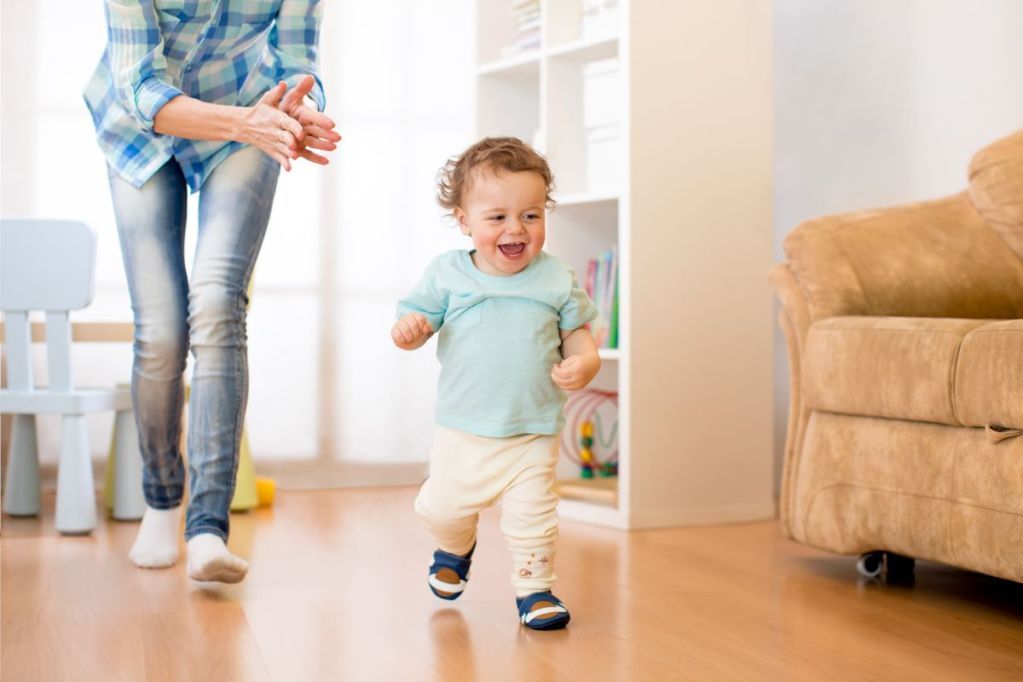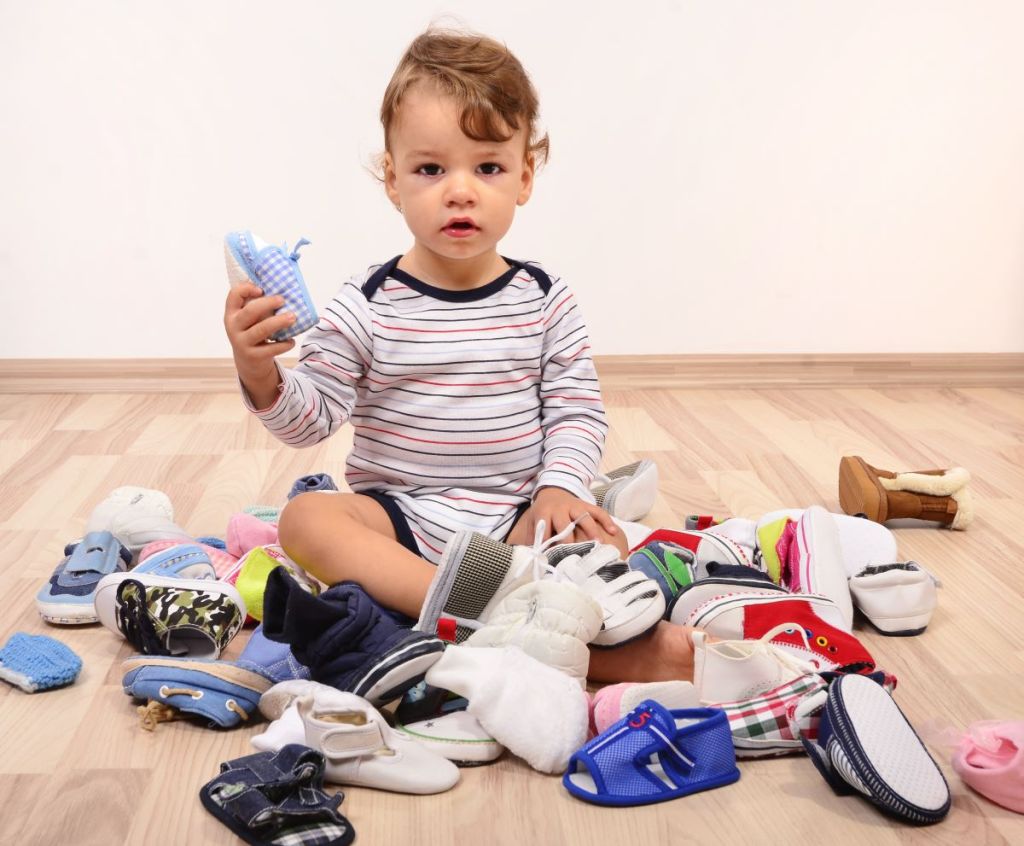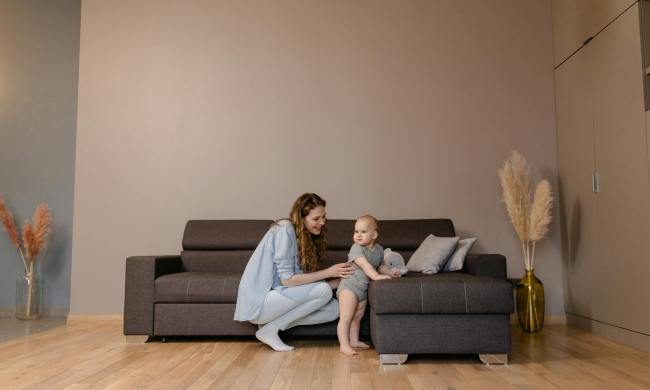Everything about baby clothes is simply adorable, but many agree that baby shoes are probably the cutest part of an outfit. After all, few things are more endearing than a pair of teeny tiny baby shoes. They can certainly serve to accessorize all those cute outfits you’ve purchased for your little one, but many wonder when baby shoes go from fashion to function. Besides being wonderfully charming, baby shoes do serve a purpose by protecting your little ones’ precious toes while helping them on the journey to independence and mobility.
The decision of whether to buy those adorable shoes for a baby does come with some questions. When should you buy baby shoes for your cutie? When should babies wear shoes? Should babies wear shoes when learning to walk or are bare feet better? Let’s take our shoes off and find out.

Does a baby need shoes?
While it might be tempting to scoop up every adorable pair of newborn and infant shoes you lay eyes on, the truth is babies do not need footwear in their first few months. You can, of course, feel free to add them to the occasional outfit, but experts suggest you should try to keep your infant’s feet bare whenever possible. According to the American Academy of Pediatrics, a baby’s feet shouldn’t be stuck inside a shoe during those early months when his or her feet are developing. A pair of socks will keep those sweet feet sufficiently covered around the house.
During those chilly winter months, you might want a slip-on baby shoe over the sock to make sure those tootsies stay toasty. There are crawler or pre-walker shoe options that are specifically made to keep socks in place and get your baby accustomed to the idea of wearing something on their feet. Think of these as practice for the real deal — and use them only as needed.

When should babies wear shoes?
All babies are different, but generally speaking, most babies take their first steps around their first birthday. Some babies walk early at nine months while others may not take those exciting first steps until around 17 or 18 months. Wearing shoes will not make a baby walk any sooner. Every little one takes his or her first steps when ready. According to Sanford Health, wearing shoes too early may hinder a baby’s natural foot development.
Once babies take those milestone first steps, going barefoot helps them grip the floor and build strength and stability in their arches and ankles as they learn to walk. This is why it’s important to let babies walk barefoot as much as possible in the home. If the weather is chilly and the floors are cold, slip on non-skid socks or booties when the baby is walking around. It’s time to go shoe shopping when a baby or toddler is ready to head outdoors and walk around. Baby shoes are needed to protect the feet when little ones are walking on rough surfaces like the ground or sidewalks.
When your little one starts racing around or running, it is time for that first pair of shoes. Before heading to the shoe store keep in mind that what’s cute is not necessarily what’s best for feet. You also don’t have to waste your money on a pair of Nike sneakers for your little one. Baby and toddler feet grow quickly and any pair of shoes you buy will most likely be outgrown in a couple of months.

What to look for in baby shoes
Now that your baby or toddler is zipping around, do you want to make a beeline to the store to snag that coveted first pair for your peanut? While cuteness and cost should certainly factor into your purchase-making process, there are some other things you should consider, too. Here is what you need to look for in terms of size, fit, and function for your baby or toddler’s first pair of shoes:
- Snug with room: You do not want your baby to slip out of their shoes while racing around. They should fit snugly throughout the foot and heel but offer a bit of room for growth at the toe. Your baby’s little feet will grow fast, and you’ll want their shoes to keep up.
- Nonslip grip: A good pair of baby shoes has a nonskid bottom with ridges to help prevent slips and spills.
- Flexible support: Baby shoes should be flexible and bendable, offering ample support but lots of give. There should be padding under the sole and heel to prevent uncomfortable friction.
- Measure often: It is usually best to have your baby fitted for their first pair of shoes, so you can ensure proper sizing. Of course, you can also do this yourself with a simple ruler. Newborns up to three months of age will typically wear a size one — which measures approximately 3.5 inches in length. From three to six months, a size two (3.75 inches) should get the job done. Around one year, many babies wear a size four and a half or five (about 4.75 inches). Again, every baby grows differently, so having the salesperson measure your little one’s feet each time you purchase a pair of shoes is a good idea.

Shoes you should skip
We know baby shoes are super sweet, but when your baby or toddler is finally ready to wear shoes don’t fall into the cute trap. Sometimes trendy shoes are better left on the shelf when it comes to little ones. Avoid these shoes that are most certainly a tripping hazard for new walkers.
- Flip-flops
- Crocs
- Jelly sandals
Young walkers should have hard-soled, closed-toe shoes.

Are used baby shoes OK?
Baby’s first pair of shoes doesn’t have to be expensive, but they should be new. The problem with hand-me-down shoes is that shoes mold to fit a child’s foot. When you put on a pair of gently used baby shoes on your kiddo, you are making his or her foot fit the shape of the shoe instead of the other way around. WebMD recommends parents stick with new shoes for babies and toddlers over hand-me-downs.
Gently used baby shoes can give your little one blisters, since your baby’s foot won’t necessarily fit the worn patterns of the hand-me-down shoes. While you want a quality shoe for your now-walking baby or toddler, it doesn’t have to be a high-end pair. Just make sure the sole is solid with a good grip, has a closed toe, and is in a size that’s a comfortable fit.

When to buy your baby new shoes
Babies tend to grow out of things quickly, and as they grow into toddlers, they’ll start to wear out their clothing and shoes. As your little one is learning to walk, they must have shoes that fit well and are in good condition. Your baby may not be bothered by shoes that are too small, so parents must be ensuring a proper fit each time they put them on. If you notice they are getting too snug, it’s time for a new pair.
If you notice the lining of the shoes is worn, especially near the heel, it’s time for a new pair. The same goes if you notice any kinds of blisters or marks on your baby’s feet. Worn lining and blisters can be indicators of shoes that aren’t fitted properly for your baby, according to Bobux. While it can be tempting to buy a pair of shoes slightly bigger, this may cause discomfort and blisters for your little one.

A final word on when babies should wear shoes
Shoe shopping takes on a whole new level of cuteness when buying for a baby or toddler. Have fun browsing all those miniature accessories, but be sure to always prioritize practicality. It’s best for the baby’s developing feet to be bare or with non-skid socks on. When a baby takes those exciting first steps, it’s important for the feet to be bare as he or she learns how to walk with confidence.
Once they’re zipping around and ready to take it outside, head to the shoe store. The right shoes will help your little one take those all-important first steps with pride, confidence, and joy. Watch out world, your baby is on the move, and soon, they’ll need to learn how to tie shoes.



